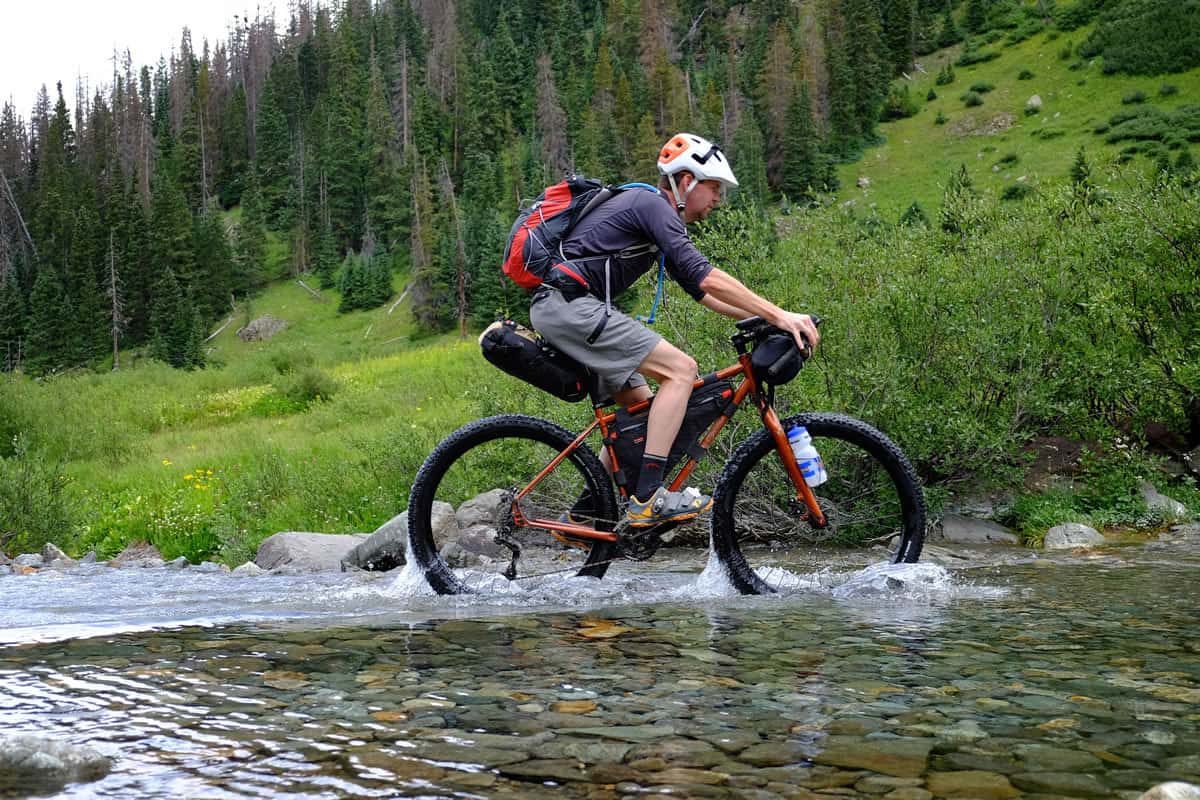Whether you’re just heading out for a quick fitness ride or traversing a continent, every rider must be ready for the mechanical woes that frequently disrupt an otherwise perfect bike ride. No matter how well maintained your bike is, there’s still a chance something wildly unexpected could happen like having a squirrel dive into your rear wheel and jam in your front derailleur. Yes, that actually happened.
Over the years I’ve developed a fairly comprehensive repair kit which I take on every ride, long or short. It represents an evolution in bike technology as tools and replacement parts are added and subtracted with changes in bike tech. One of the welcome advancements is the reduction in the number of tools required to fix and adjust various components. It’s amazing what can be accomplished with just a few Allen wrenches. Below is a breakdown of what I carry in case of—well, a breakdown.

After 12 hard days on the trail in Iceland I finally had a day of sun to dry out my camping gear and give my bike a quick clean and tune. It needed it badly after 2 weeks of volcanic sand, river crossings, and rain.
Flat Fixings
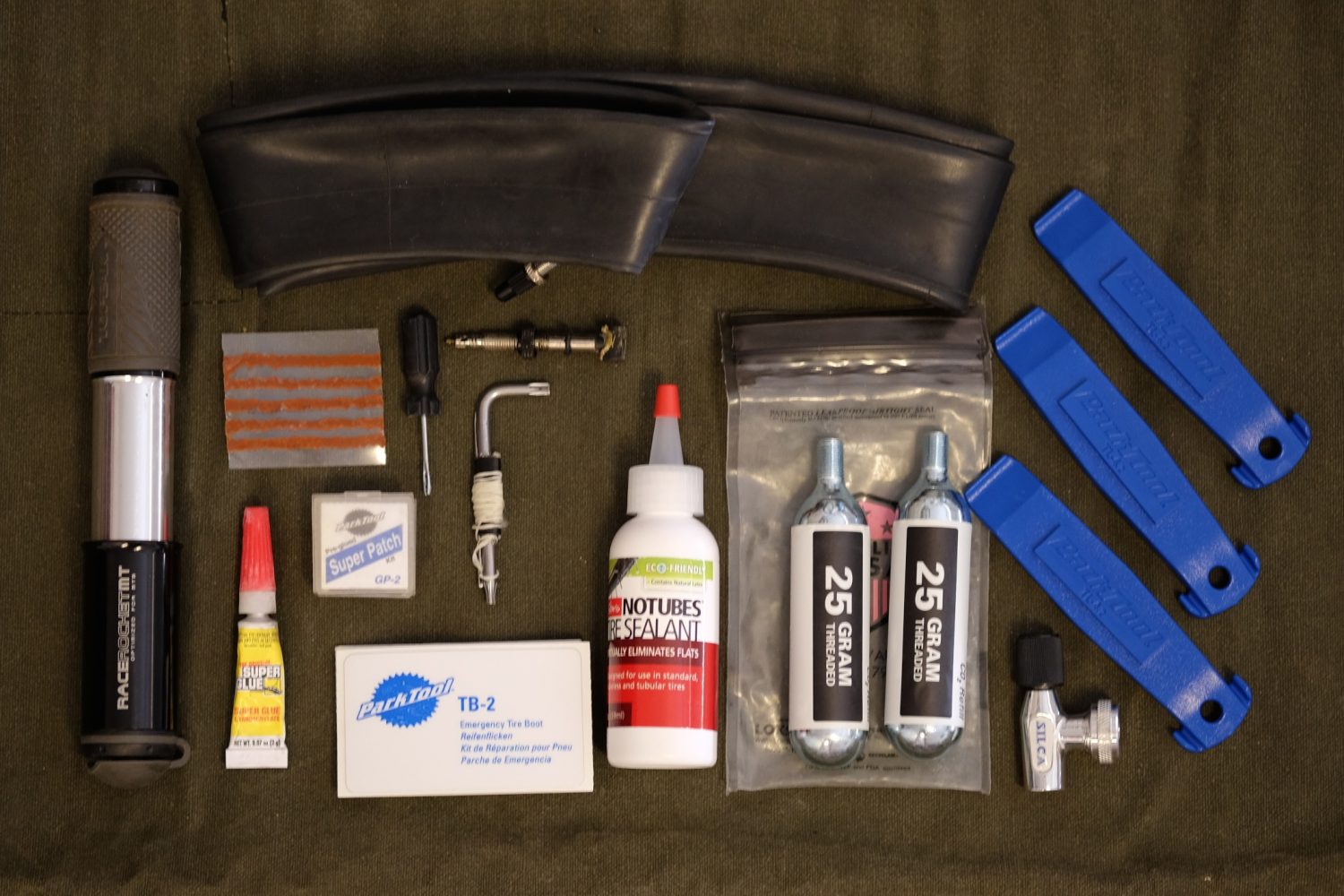 The most common trailside repair is the flat tire. Whether you use tubes or have followed the rapid trend toward tubeless systems, retaining air remains a troublesome pursuit. My flat-fixing kit has ballooned over the years in response to the many new methods available to repair a damaged tire. Comprehensive as it is, it isn’t too heavy nor does it take up too much space.
The most common trailside repair is the flat tire. Whether you use tubes or have followed the rapid trend toward tubeless systems, retaining air remains a troublesome pursuit. My flat-fixing kit has ballooned over the years in response to the many new methods available to repair a damaged tire. Comprehensive as it is, it isn’t too heavy nor does it take up too much space.
- Spare tube: This is a no-brainer. Whether you run tubes or go tubeless, the ability to pop in a fresh tube is often the quickest fix. I try to always carry a brand new, un-patched spare tube and inspect it often to ensure it hasn’t developed damage while bouncing around in a pack.
- Tire levers: I always carry three robust levers in the event one gets lost or broken. Most modern tubeless tires require two levers to remove or mount.
- Patches and boots: I’m a bit of an anomaly in that I prefer pre-glued patches. I find they work great if you use them properly and they’re quick to apply. Park Tool tire boots are another staple and allow me to ride on torn tire casings. I often pack alcohol pads to clean the tire before applying the boot.
- Tire plugs: These little plugs from Genuine Innovations are cheap, easy to use, and while they don’t always work, they do more frequently than I expect them to. In some cases, a couple of plugs paired to an extra dose of sealant can keep me rolling.
- Co2 cartridges and inflator: It’s not very often I need to seat a tubeless tire in the sticks, but when I do, having a high volume 25-gram Co2 cartridge is handy. I also like having them when I’m pressed for time. Maybe I’m running short on daylight or riding with a group and want to cut my pumping time and effort. They are heavy, but very convenient.
- Needle and thread: I typically use a curved upholstery needle with heavy-duty thread, but sometimes dental floss works in a pinch. It’s a great thing to have when you get a major sidewall gash. I keep my needle and thread wrapped around a spare torx tool as they’re prone to strip.
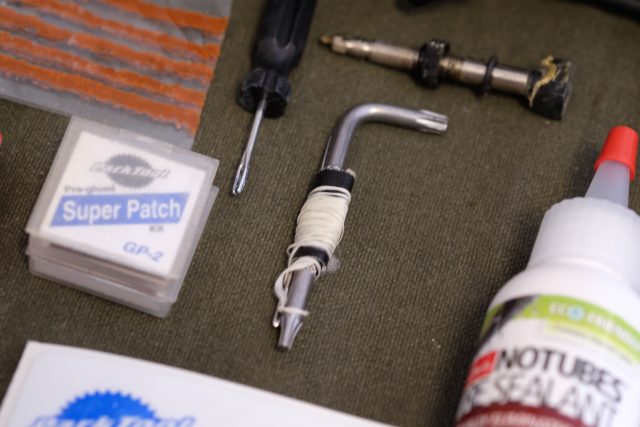 Super glue: The glue of many uses can be used to seal some small cuts in tires.
Super glue: The glue of many uses can be used to seal some small cuts in tires.- Tire sealant: My favorite quick fix is often just to dump more sealant into a leaking tire and ride on. In many cases, my sealant has dried to the point of losing efficiency, so a little refresher dose is often all I need to keep rolling. For long trips, I might even carry two small bottles.
- Pump: I’ve tried dozens of pumps over the years and my favorite by far is the Topeak Race Rocket MT. Efficient and durable, they have yet to fail me. Plus, the added length of hose places reduced stress on valves during inflation.
- Spare air valves: Valves can get damaged, so I like to carry at least one extra, sometimes two for longer trips.
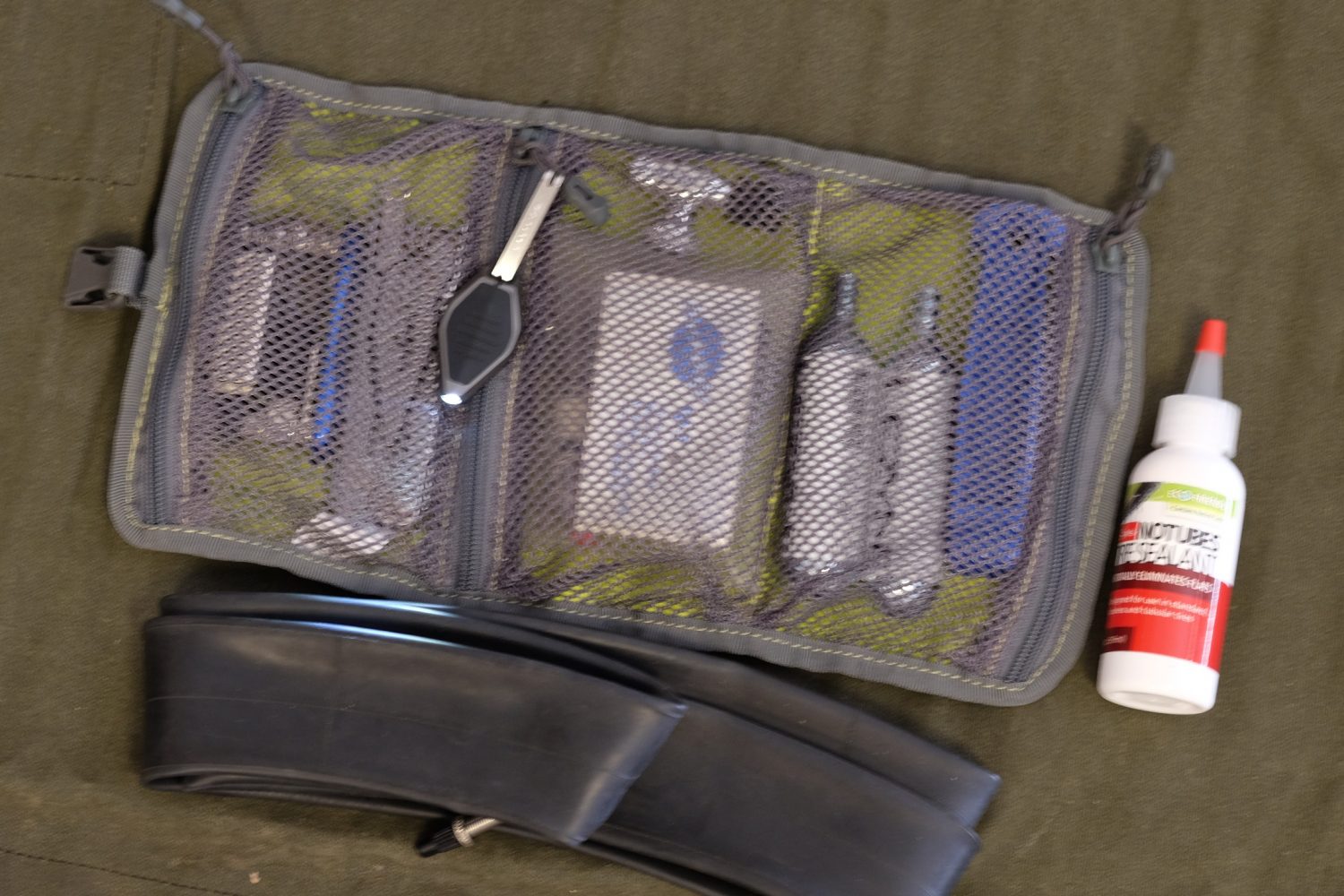
I’m a chronic organizer. This Camelbak tool roll allows me to see everything at a glance. I try to inspect my kit with every few rides.
Tools
Although I feel compelled to knock on wood while I say it, I do think today’s bikes are pretty reliable. My tools primarily get used for minor adjustments and tweaks, but I try to carry everything I need to remedy a major mechanical breakdown.
- Park MT-40: This folding tool is not only burly and stout, it has everything I need and nothing more. It includes a chain tool, Co2 inflator chuck, and a handful of common Allen and Torx wrenches. Lighter tools can be found, but when you need a tool, you don’t need it to be light, you need it to be strong and proficient.

- SOG Paratool: I added this tool to my kit several years ago and in that time have used it more than I thought I would. The pliers make sewing tire tears easy and the knife has been called to duty regularly. It’s heavy, but worth its spot in my pack.
- Flashlight: I’ve had two major tire gnashing flats in the dark. It was the darkness itself that caused the flats as I couldn’t easily see the rocks in the trail. It would be impossible to stitch up a sidewall in the dark, so a light is a must.
Spares and Miscellaneous Repair Aids
Many of the extras I take along on each ride are extremely helpful when needed, but weigh only grams in my pack. If you’re unsure whether or not to pack a spare, just do it. Better safe than sorry.
- Zip Ties: These universal repair ties have millions of uses. From securing brake lines to affixing a seized brake caliper to a fork leg, they’re hard to do without.
- Gorilla tape: I usually keep quite a bit of sticky Gorilla tape wrapped around my pump or seatpost. I’ve even used it to extract hundreds of cactus needles from my hand when I crashed in a patch of prickly pear cactus.
- Latex gloves: When you get a serious drivetrain mechanical, sometimes latex gloves are nice to keep the mess under control. This is particularly beneficial on multi-day rides where a thorough wash-up is not easy.
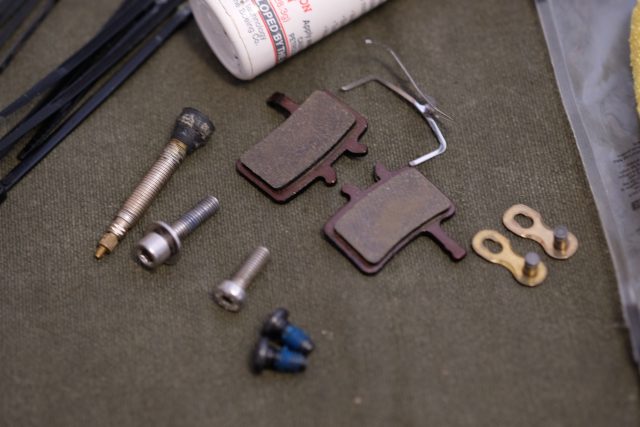
- Lube: For short trips, I skip extra lube. For multi-day rides, I always bring a small bottle. I can only tolerate a squeaky chain or pulley for a few hours.
- Chain link: Chains break and the best way to make a quick repair is with a replaceable master link. Be sure to carry the right link for your drivetrain, but don’t hesitate to carry others for your buddies who fail to be equally prepared. I carry 11-, 10-, and even 9-speed Power Links. They don’t weigh more than a few grams each.
- Spare bolts: You never know when you’re going to lose a crank, cleat, rotor, or bottle cage bolt. Like the chain links, they don’t weigh more than a few grams.
- Spare brake pads: I never leave on even a short multi-day trip without extra brake pads. Easy to install on the trail, they’ve saved the day more than once.
Prepare for the Worst
In many cases, trailside fixes can be executed quickly with little fuss. It’s tempting to want to limit how much extra stuff you pack on your bike or back, but most tools and spares are small enough to not add any noticeable weight or bulk to your ride. Sometimes it seems like it’s all for naught as I can go thousands of miles without so much as a flat. But then again, there’s always that suicidal squirrel you never saw coming. – CN




